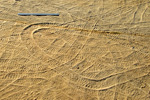

Blackberry Hill |
|||||||||||||
Location: Near Mosinee, Marathon County, Wisconsin Time: About 500 million years ago, during the Cambrian period About this Famous Find: Located in Central Wisconsin, Blackberry Hill is a series of quarries generally recognized as containing the largest concentration of trace fossils in Cambrian intertidal rocks. One quarry in particular, located near Mosinee, Marathon County, also has the distinction of preserving some of the first animals to crawl out of the sea and the greatest concentration of large, stranded jellyfish fossils. Two trace fossils dominate. The distinctive Climactichnites, which somewhat resembles motorcycle tracks, is the most abundant trackway of Blackberry Hill, literally covering the surfaces of some layers. Attributed to many organisms at various times since 1860, when Sir William Logan named it based on fossils from Ontario, Climactichnites is now thought to have been made by a slug-like animal as it moved about and processed the sediment to obtain food. Described by Sir Richard Owen in 1852, Protichnites, with its linear depression running between the dimple-like footprints, is believed to be the tracks of arthropods with dragging tails. The Protichnites from Blackberry Hill includes P. eremita Hagadorn and Seilacher, 2009, which has been postulated to be the trackways of the first animal to exhibit hermit behavior, whereby the arthropod used a snail shell to keep its gills moist. The Protichnites of Blackberry Hill may have been produced by the euthycarcinoid Mosineia macnaughtoni Collette and Hagadorn, 2010, an arthropod recently discovered at Blackberry Hill that appears to have flattened appendages and a pointed tail capable of producing those trace fossils. Many other types of trace fossils believed to have been made by various arthropods and annelids are also very common at Blackberry Hill. Some of the tracks at Blackberry Hill may have been made subaerially — that is, on land — as indicated by the presence of raindrop impressions associated with the tracks. No occurrences of possible animal life exploiting a subaerial environment have been found in rocks older than these. Microbial mats or similar organic structures on the sediment surfaces may have had a binding effect that helped preserve the tracks, and may have provided the nourishment that lured the animals onto the land.
|
|
site tour |
about the site |
site map |
site credits |
page credits |
help |
FAQs |
contact |
||

